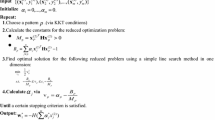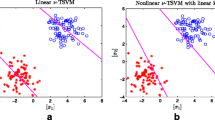Abstract
In this paper, a novel nonparallel hyperplane based classifier termed as “angle-based twin support vector machine” (ATWSVM) has been proposed which is motivated by the concept of twin support vector machine (TWSVM). TWSVM obtains two nonparallel hyperplanes by solving a pair of quadratic programming problems (QPPs). ATWSVM presents a generic classification model, where the first problem can be formulated using a TWSVM-based classifier and the second problem is an unconstrained minimization problem (UMP) which is reduced to solving a system of linear equations. The second hyperplane is determined so that it is proximal to its own class and the angle between the normals to the two hyperplanes is maximized. The notion of angle has been introduced to have maximum separation between the two hyperplanes. In this work, we have presented two versions of ATWSVM: one that solves a QPP and a UMP; second which formulates both the problems as UMPs. The training time of ATWSVM is much less than that of TWSVM because ATWSVM solves the second problem as UMP instead of QPP. To test the efficacy of the proposed classifier, experiments have been conducted on synthetic and benchmark datasets and it is observed that the proposed classifier achieves classification accuracy comparable or better than that of TWSVM. This work also proposes application of ATWSVM for color image segmentation.






Similar content being viewed by others
References
Arbelaez, P., Fowlkes, C., & Martin, D. (2007). The Berkeley segmentation dataset and bench-mark. http://www.eecs.berkeley.edu/Research/Projects/CS/vision/bsds
Blake, C., & Merz, C. J. (1998) UCI repository of machine learning databases. http://www.ics.uci.edu/mlearn/MLRepository.html
Burges, C. J. (1998). A tutorial on support vector machines for pattern recognition. Data Mining and Knowledge Discovery, 2(2), 121–167.
Cortes, C., & Vapnik, V. (1995). Support-vector networks. Machine Learning, 20(3), 273–297.
Demšar, J. (2006). Statistical comparisons of classifiers over multiple data sets. The Journal of Machine Learning Research, 7, 1–30.
Duda, R. O., Hart, P. E., & Stork, D. G. (2012). Pattern classification. New York: Wiley.
Hsu, C. W., Chang, C. C., & Lin, C. J. (2003). A practical guide to support vector classification. http://www.csie.ntu.edu.tw/~cjlin/papers/guide/guide.pdf.
Jain, A. K. (2010). Data clustering: 50 years beyond k-means. Pattern Recognition Letters, 31(8), 651–666.
Jayadeva, Khemchandani, R., & Chandra, S. (2007). Twin support vector machines for pattern classification. IEEE Transactions on Pattern Analysis and Machine Intelligence, 29(5), 905–910.
Jayadeva, Khemchandani, R., & Chandra, S. (2016). Twin support vector machines: Models, extensions and applications (Vol. 659). Berlin: Springer.
Jumutc, V., & Suykens, J. A. (2014). Multi-class supervised novelty detection. IEEE Transactions on Pattern Analysis and Machine Intelligence, 36(12), 2510–2523.
Khemchandani, R. (2008). Mathematical programming applications in machine learning. Ph.D. thesis, Indian Institute of Technology, Delhi, New Delhi, India
Khemchandani, R., Saigal, P., & Chandra, S. (2016). Improvements on \(\nu \)-twin support vector machine. Neural Networks, 79, 97–107.
Kumar, M. A., & Gopal, M. (2009). Least squares twin support vector machines for pattern classification. Expert Systems with Applications, 36(4), 7535–7543.
Lee, Y. J., & Mangasarian, O. L. (2001). RSVM: Reduced support vector machines. SIAM International Conference on Data Mining, 2001, 1–17.
Lee, Y. J., & Mangasarian, O. L. (2001). SSVM: A smooth support vector machine for classification. Computational Optimization and Applications, 20(1), 5–22.
Mangasarian, O. L. (1993). Nonlinear programming (Vol. 10). New Delhi: SIAM.
Mangasarian, O. L., & Wild, E. W. (2001). Proximal support vector machine classifiers. In KDD-2001: Knowledge discovery and data mining, Citeseer.
Mangasarian, O. L., & Wild, E. W. (2006). Multisurface proximal support vector machine classification via generalized eigenvalues. IEEE Transactions on Pattern Analysis and Machine Intelligence, 28(1), 69–74.
Manjunath, B. S., & Ma, W. Y. (1996). Texture features for browsing and retrieval of image data. IEEE Transactions on Pattern Analysis and Machine Intelligence, 18(8), 837–842.
Musicant, D. (1998). NDC: Normally distributed clustered datasets. Madison: Computer Sciences Department, University of Wisconsin.
Peng, X. (2011). TPMSVM: A novel twin parametric-margin support vector machine for pattern recognition. Pattern Recognition, 44(10), 2678–2692.
Shao, Y. H., Deng, N. Y., & Yang, Z. M. (2012). Least squares recursive projection twin support vector machine for classification. Pattern Recognition, 45(6), 2299–2307.
Shao, Y. H., Zhang, C. H., Wang, X. B., & Deng, N. Y. (2011). Improvements on twin support vector machines. IEEE Transactions on Neural Networks, 22(6), 962–968.
Shao, Y. H., Chen, W. J., & Deng, N. Y. (2014). Nonparallel hyperplane support vector machine for binary classification problems. Information Sciences, 263, 22–35.
Shao, Y. H., Wang, Z., Chen, W. J., & Deng, N. Y. (2013). A regularization for the projection twin support vector machine. Knowledge-Based Systems, 37, 203–210.
Suykens, J. A., & Vandewalle, J. (1999). Least squares support vector machine classifiers. Neural Processing Letters, 9(3), 293–300.
Tanveer, M., Shubham, K., Aldhaifallah, M., & Ho, S. S. (2016). An efficient regularized k-nearest neighbor based weighted twin support vector regression. Knowledge-Based Systems, 94, 70–87.
Tanveer, M., Khan, M. A., & Ho, S. S. (2016). Robust energy-based least squares twin support vector machines. Applied Intelligence, 45(1), 174–186.
Tian, Y., Ju, X., Qi, Z., & Shi, Y. (2014). Improved twin support vector machine. Science China Mathematics, 57(2), 417–432.
Tian, Y., & Ping, Y. (2014). Large-scale linear nonparallel support vector machine solver. Neural Networks, 50, 166–74.
Tian, Y. J., & Ju, X. C. (2015). Nonparallel support vector machine based on one optimization problem for pattern recognition. Journal of the Operations Research Society of China, 3(4), 499–519.
Vapnik, V. (2000). The nature of statistical learning theory. Berlin: Springer.
Xu, Y. (2016). Maximum Margin of Twin Spheres Support Vector Machine for Imbalanced Data Classification. IEEE Transactions on Cybernetics, 99, 1–11.
Yang, Z. M., Wu, H. J., Li, C. N., & Shao, Y. H. (2016). Least squares recursive projection twin support vector machine for multi-class classification. International Journal of Machine Learning and Cybernetics, 7(3), 411–426.
Zhao, J., Yang, Z., & Xu, Y. (2016). Nonparallel least square support vector machine for classification. Applied Intelligence, 45(4), 1119–1128.
Author information
Authors and Affiliations
Corresponding author
Rights and permissions
About this article
Cite this article
Khemchandani, R., Saigal, P. & Chandra, S. Angle-based twin support vector machine. Ann Oper Res 269, 387–417 (2018). https://doi.org/10.1007/s10479-017-2604-2
Published:
Issue Date:
DOI: https://doi.org/10.1007/s10479-017-2604-2




